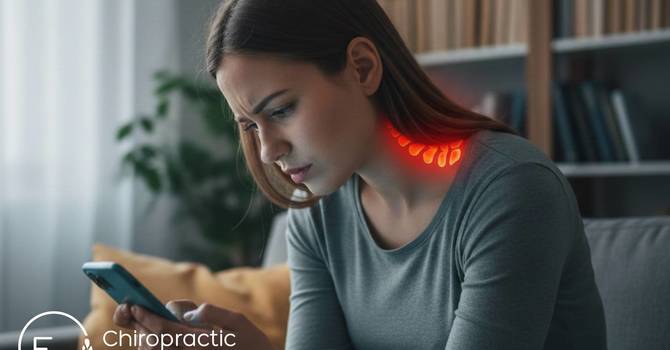Neck Pain Affects How You Sleep, Drive And Even How You Can Cross The Street Safely
Neck pain isn't just inconvenient, it can put you at risk of further injury. We offer chiropractic treatment to anyone experiencing neck pain in Saskatoon.
Neck pain is a very common issue in our society, and understanding the causes and prevention of neck pain will go a long way to leading a healthy and pain-free life. Here are some of the most common causes of neck pain we see in our office:
- Cervical Joint Irritation
- Cervical Sprain/Strains
- Cervical Disc Disorders
- Whiplash
The Chiropractors and Physiotherapists at E3 Chiropractic + Wellness are well-trained to find the exact cause of your neck pain and provide you the tools you need to get out of pain!
Understand Your Neck
Cervical Joint Irritation
Your neck is made up of seven bones stacked on top of each other with a soft "disc" between each segment to allow for flexibility. Normally, each joint in your neck should move freely and independently. When one or more of the joints in your neck is slightly restricted, we call this condition "cervical segmental joint restriction".
To help visualize this, imagine a normal neck functioning like a big spring moving freely in every direction. A neck with a joint restriction is like having a section of that spring welded together. The spring may still move as a whole, but a portion is no longer functioning.
The Main Causes of Joint Irritation Are:
- Accident or Injury
- Repetitive Strains
- Poor Posture
- Compensation from Other Joints
Symptoms of Joint Irritation
Joint restrictions most commonly cause local tenderness and discomfort. You may notice that your range of motion is limited. Moving your head and neck may increase your discomfort. Pain from a restricted joint often trickles down to your shoulders and upper back. Headaches, light-headedness, and/or jaw problems may result from joint restrictions in your upper neck
Cervical Sprain/Strain
Cervical strains and sprains are some of the most common injuries sustained to the cervical spine.
A cervical strain is when an injury occurs to the muscles of the cervical spine.
On the other hand, a sprain is an injury to the ligaments or joints; both have similar pain and symptom patterns. Patients with this diagnosis often have pain when attempting to move the head and neck, especially at end ranges of motion.
Another symptom sufferers may experience is frequent headaches, which may not seem directly evident to the patient that their cervical strain or sprain may be the source of the headaches.
The Main Physical Causes of a Sprain/Strain Are:
- Automobile accidents
- Whiplash
- Contact sports injuries
- Repetitive overuse injury
- Prolonged poor posture
Some of these injuries are impossible to avoid, such as traumatic automobile accidents and whiplash injuries. At this point, there are no steps for prevention. Your next action is to seek treatment, usually with ice in the days immediately following the injury, as well as therapeutic modalities such as interferential electrical stimulation, Active Release Technique, and massage.
In cases where the injury stems from a problem related to overuse, poor posture or improper exercise, some steps can be taken to help avoid these injuries from happening. Proper training in ergonomics in the workplace, fixing posture and instilling healthy habits, and receiving the proper exercise knowledge can help build a better foundation for a healthy spine for life.
Cervical Disc Disorder
Discogenic Pain Syndrome is a condition that results from soft tissue damage and associated irritation of the fibres of intervertebral discs.
Intervertebral discs are cushions found between each vertebra of the spine. The cervical discs are found between the vertebrae of the spine in the area we think of as the neck.
Intervertebral discs consist of an outer annulus fibrous, made up of tough, fibrous connective tissue, which surrounds a gel-like center called the nucleus pulposus. The outer third of the annulus fibrous is innervated by nerves and contains pain and mechanical receptors that mediate pain transmission from structural damage to the intervertebral discs or indirectly through chemically mediated inflammation.
Cervical disc pain can arise from various reasons, whether by injury or a degenerative condition. In most cases, the condition can be treated to allow the person to continue his/hers active lifestyle.
Causes of Cervical Discogenic Pain Syndrome
- Direct trauma - falls, motor vehicle accident, whiplash, sports injury
- Overuse, fatigue, repetitive microtrauma - over hours, days, months of the same position
- Postural - can be either an intrinsic postural problem (e.g. loss of cervical curvature) or an extrinsic postural problem (e.g. prolonged stressful position, protruded head posture).
- Sudden unguarded movement.
- Degenerative disc disease.
Symptoms of Cervical Discogenic Pain Syndrome
The symptoms will vary, whether the pain is due to a herniated disc or by a degenerative disc.
With a herniated disc, some people will not experience pain in the neck but radiating pain, tingling, and numbness down the arm or around the shoulder blade due to pressure put on the nerve root.
Discogenic pain from an injury can result in immediate pain or pain shortly after the injury. Headaches (usually cervicogenic) can also result from cervical disc pain.
If you are experiencing neck pain, we recommend getting checked out right away
Our team will assess and work together to get you out of pain.
Don't let the side effects from neck pain stop you from enjoying your favourite activities. Book an appointment with E3 today!

